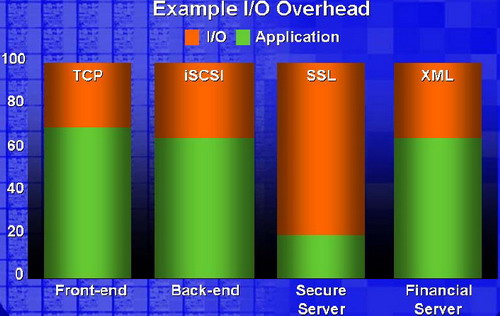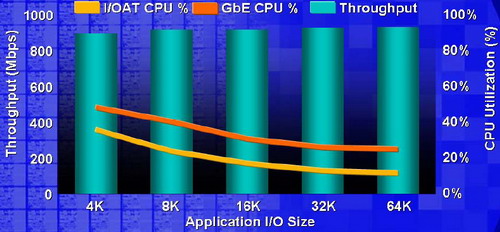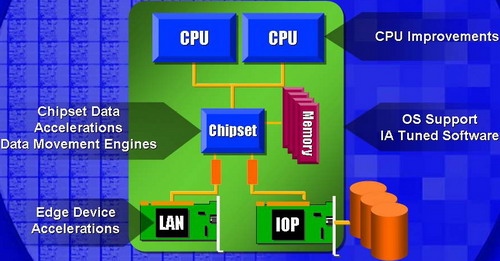IDF Spring 2005 Day 1 - Gelsinger Speaks, nForce4 Intel and more
by Anand Lal Shimpi & Derek Wilson on March 2, 2005 3:00 AM EST- Posted in
- Trade Shows
Our first day of IDF coverage has come to a close, and it has been quite eventful. From the barrage of multicore information, to the 64bit evangelism, down to the tech showcase, we've seen quite a bit from Intel.
It is usually a pleasure to listen to Pat Gelsinger deliver a keynote, and today was no different. The Intel VP took us through new technologies from Intel that will be introduced over the next year or two. Included in the long list of topics covered are network acceleration, advanced management features, virtualization, and, of course, multicore. We got to see a 32-way Itanium machine recognize faces in a split second, as well as another demo of Intel's virtualization technology -- this time focused on security.
On the floor of the tech showcase, we saw quite a few interesting booths. There is everything from fuel cell and battery research, to new a new server oriented chip from ATI (which we will talk more about later in the week). Also appearing is the NVIDIA nForce 4 SLI Intel Edition, brining into light the fruits of the NVIDIA/Intel cross-licensing agreement announced in November. We'll be talking more about these and other exciting exhibits over the course of IDF.
We hope you enjoy the conclusion to our coverage of IDF Spring 2005 Day 1. It's time for us to collapse into dreamland and prepare for another big day tomorrow.
Intel I/O Acceleration Technology: Improving Network Performance
When looking at network servers, a huge percentage of the overall work being done has to do with protocol overhead processing. In order to get more of the work the users is interested in done, the industry has pushed forth network hardware that handles some of the overhead of TCP/IP processing. Network cards that include a TCP Offload Engine (TOE) are able to help reduce overhead processing done on the server's CPUs.

Rather than simply rely on a NIC with a TOE, Intel has found that improving the rest of the platform is actually a better way of handling network overhead (especially when looking at many small packets).

We didn't get an in depth technical look at IOAT at Pat's keynote today, but we do have a little general information. The slide we are looking at lists "CPU Improvements" and "OS Support/IA Tuned Software" as architectural enhancements behind IOAT. Making faster and more parallel processors will definitely help without needing any IOAT specific optimizations, and OS support of hardware features is usually a prerequisite for their use. Of course there could be more too these aspects of the technology, but we'll have to wait an see. The real meat likely comes in the chipset data accelerations, Data Movement Engines, and Edge Device Accelerations. We could envision enhancements to the NIC and chipset that allow for further removed overhead processing as well as optimized or prioritized movement of data through they system. We'll bring out more details as we get them.











19 Comments
View All Comments
mickyb - Wednesday, March 2, 2005 - link
Doesn't Intel's GOAT (Eh hmm IOAT) sound a lot like what nVidia was doing with their I/O chips? Intel should put "Not to scale" or "No real data was found" on every single one of those extrapolation graphs. I find it kind of funny how multi-core is the panacea to all performance problems. How is this any different than multi CPU SMP? It isn't, except for compressing them to a smaller space. SMP has its problems as well and the number of CPUs does not create an exponential graph like Intel is implying.I am interrested in this FBDIMM and will need to do some checking around on that one. It looks interesting. RAMBUS is still at it. We'll see how things shape up.
glennpratt - Wednesday, March 2, 2005 - link
That changes his point very little. And, YOU probably won't be buying crap out of pocket...Questar - Wednesday, March 2, 2005 - link
When will you guys realize how small the gaming market is?I'll buy more corporate systems this year than every gamer on this site will buy in the next five years.
Pete84 - Wednesday, March 2, 2005 - link
^^ Not just games, but every app too . . .ZobarStyl - Wednesday, March 2, 2005 - link
I love the graph on page 4, where multicore just jumps ahead by leaps and bounds, with the "Performance" being exponential growth. I'm sorry but the last time we saw something like this it was the NetBurst graph taking us into "10 GHz Space" and lo and behold, well you know the story. I'm so tired of Intel just putting a band-aid on a bad idea for a chip (not a bad chip mind you, just designed by marketing people, not engineers). Multicore without onboard memory controllers, tacking on an extra meg of slower cache to Prescott...why are we not seeing samples of a new chip that aims to correct the problems of NetBurst rather than just adding more and more to Prescott like it really is going to change the fact? Until games get really multi-core oriented, this last generation of single-core products is going to be the best thing out there until probably late 06.raskren - Wednesday, March 2, 2005 - link
^^You^^Guess what, none of these are anywhere near store shelves so CTFD (calm the F down).
The Nforce4 board finally adds some appeal to the latest Pentium 4s. I'd say that i875/865 were the last two exciting chipsets. 9xx has fallen short on innovation.
Beenthere - Wednesday, March 2, 2005 - link
The SpinMeisters from Intel are realing blow smoke up the azzes of journalist, as usual. Only the gullible would belive the nonsense these folks peddle when they can't even deliver a P4 without a fire extinguisher. No one with a clue would touch any of Intel's current or short term products. Maybe by '07 Intel will have something worth considering but that remains to be seen.xsilver - Wednesday, March 2, 2005 - link
The idea of VT is a good one I think -- it may be possible to run a small office on only 1 multicore, multithread system? (spreadsheets and email aren't exactly taxing)and intel's idea of split dual cores may be future possibilities of selling cpu's scaled with cores rather than clock speeds?
eg. Extreme edition will have 8 cores, regular will have 4-7 cores ... celerons will have 1-3 cores... according to how the cpu's are binned?
bersl2 - Wednesday, March 2, 2005 - link
--quote--Microsoft’s Jim Allchin came on stage and echoed Gelsinger’s statements with the simple line “it’s time.”
--quote--
Duuuuuuuu... no, really?
"And Wintel said, 'Let there be light!' But they were too slow to realize that the light had been on for quite some time."